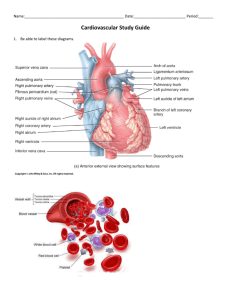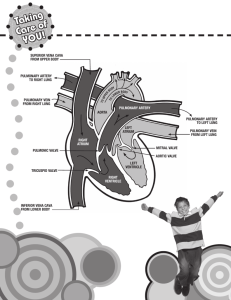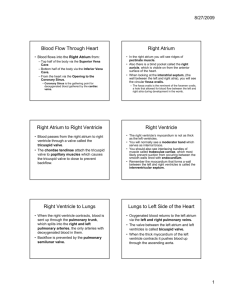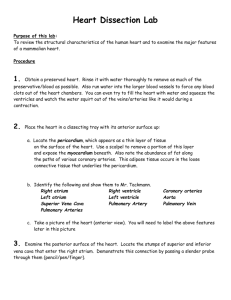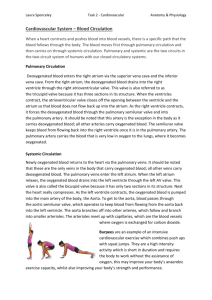Heart Disorders Glossary
advertisement
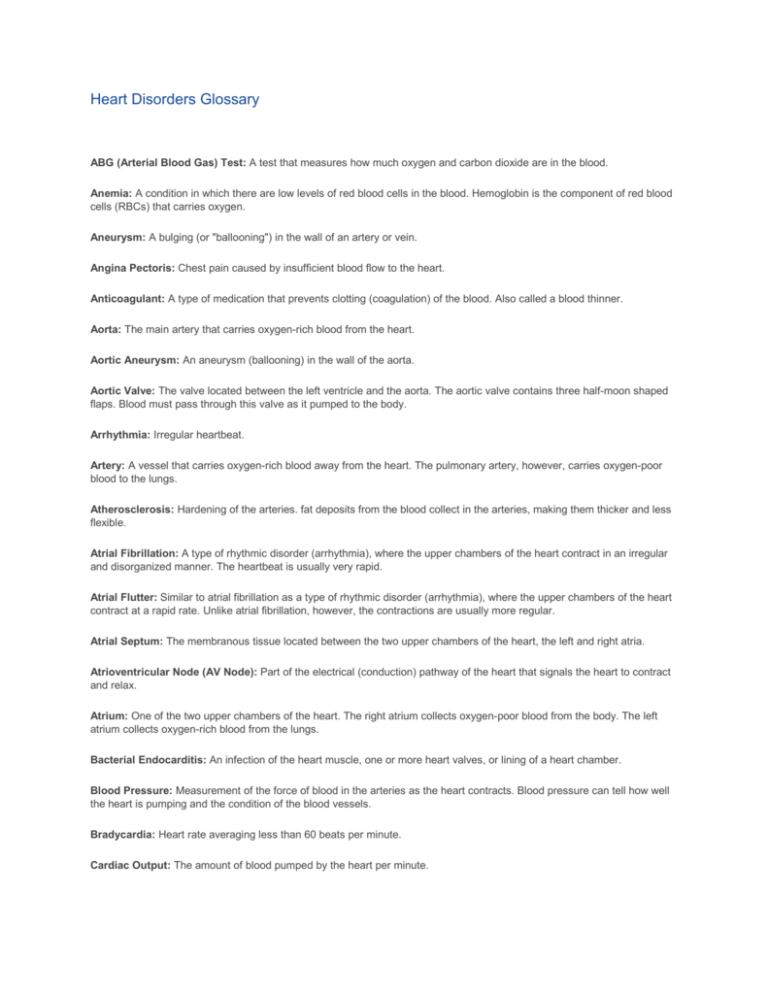
Heart Disorders Glossary ABG (Arterial Blood Gas) Test: A test that measures how much oxygen and carbon dioxide are in the blood. Anemia: A condition in which there are low levels of red blood cells in the blood. Hemoglobin is the component of red blood cells (RBCs) that carries oxygen. Aneurysm: A bulging (or "ballooning") in the wall of an artery or vein. Angina Pectoris: Chest pain caused by insufficient blood flow to the heart. Anticoagulant: A type of medication that prevents clotting (coagulation) of the blood. Also called a blood thinner. Aorta: The main artery that carries oxygen-rich blood from the heart. Aortic Aneurysm: An aneurysm (ballooning) in the wall of the aorta. Aortic Valve: The valve located between the left ventricle and the aorta. The aortic valve contains three half-moon shaped flaps. Blood must pass through this valve as it pumped to the body. Arrhythmia: Irregular heartbeat. Artery: A vessel that carries oxygen-rich blood away from the heart. The pulmonary artery, however, carries oxygen-poor blood to the lungs. Atherosclerosis: Hardening of the arteries. fat deposits from the blood collect in the arteries, making them thicker and less flexible. Atrial Fibrillation: A type of rhythmic disorder (arrhythmia), where the upper chambers of the heart contract in an irregular and disorganized manner. The heartbeat is usually very rapid. Atrial Flutter: Similar to atrial fibrillation as a type of rhythmic disorder (arrhythmia), where the upper chambers of the heart contract at a rapid rate. Unlike atrial fibrillation, however, the contractions are usually more regular. Atrial Septum: The membranous tissue located between the two upper chambers of the heart, the left and right atria. Atrioventricular Node (AV Node): Part of the electrical (conduction) pathway of the heart that signals the heart to contract and relax. Atrium: One of the two upper chambers of the heart. The right atrium collects oxygen-poor blood from the body. The left atrium collects oxygen-rich blood from the lungs. Bacterial Endocarditis: An infection of the heart muscle, one or more heart valves, or lining of a heart chamber. Blood Pressure: Measurement of the force of blood in the arteries as the heart contracts. Blood pressure can tell how well the heart is pumping and the condition of the blood vessels. Bradycardia: Heart rate averaging less than 60 beats per minute. Cardiac Output: The amount of blood pumped by the heart per minute. Cardiomyopathy: This is the general term for diseases that create a weakening of the heart muscle or create a change in the heart structure. There are several forms of cardiomyopathy. This disorder can be caused by coronary artery disease, genetic disorders, infection, alcohol abuse, high blood pressure, and some immune disorders. Cardiopulmonary Bypass: A machine that can perform the function of the heart and lung. Also known as a heart-lung machine. Catheter: A small tube used used to access the arterial or venous system in order to correct a blockage, perform diagnostic or interventional procedures in the vascular or electrical system of the heart. Catheters can also be used to measure blood pressure in the heart chambers or lungs circulation. Cholesterol: Fatty substance circulating in the blood stream which comes from dietary intake and is produced in the liver. Cholesterol is essential for the production of certain hormones and many body functions. Too much cholesterol in the blood can cause plaque to form in the arteries. Claudication: Pain, usually in the calf or thigh muscles of the leg, caused by a lack of arterial blood supply. Claudication can develop in patients with atherosclerosis. Congenital Heart Disease: Congenital heart disorders are present at birth and are characterized by a defect with the heart’s structure or function. Congestive Heart Failure (CHF): A condition whereby the heart’s pumping ability is impaired and abnormal pressure builds up in the circulation of heart and lungs. Symptoms of shortness of breath or chest tightness can develop. Fluid subsequently can collect in various parts of the body, including the lungs, lung cavities and legs. Coronary: Relating to the heart or to the coronary arteries that supply blood directly to the heart. Coronary Artery: The main blood supply to the heart muscle. The coronary arteries surround, or “crown,” the heart. Cyanosis: A condition in which a person’s skin appears blue due to lack of oxygen. Defibrillator: Medical device used to apply an internal or external electric shock to the heart in order to restore normal rhythm. Diastole: The period where the heart relaxes after a contraction. Diastolic Dysfunction: A condition where the ventricles become stiff and are therefore unable to relax normally after contracting. This can prevent the ventricle from filling with a sufficient amount of blood. As a result, there can be an abnormal “back up” of pressure into the atria and circulation to the lungs. This can produce symptoms of congestive heart failure. Dilatation: The condition of being dilated or enlarged by an internal or external force. Dyspnea: Difficulty breathing. Ectopic Beat: Irregular premature or “skipped” heartbeat arising from a focus other than the natural pacemaker of the body. Electrocardiogram: A recording of the electrical activity of the heart. Commonly referred to as EKG or ECG. Electrophysiology: Study of the electrical or conduction properties of the heart. Endocardium: The inner lining of the heart. Epicardium: The outer layer of the heart. HDL Cholesterol: High density lipoprotein. The “good” cholesterol. An HDL cholesterol measurement of 60 mg/dL or above is believed to protect against heart disease. Heart Attack: See myocardial infarction. Heart Murmur: The sound of blood flow heard through a stethoscope. A murmur may represent normal or abnormal flow, but often refers to a leak in a heart valve. Heart Rate: Heart beats per minute; “pulse”. Heart Sound: Usually refers to the sounds of the heart valves closing during the cardiac cycle of contraction and relaxation. Normal heart sounds are called S1 and S2. They are the typical “lubb-dubb” heard when listening to the heart with a stethoscope. Hemodynamics: The study of the blood flow, circulation, and pressures within the circulation of the heart and lungs. High Blood Pressure: Also called hypertension. High blood pressure is diagnosed when three consecutive blood pressure measurements over time are 140/90 mm Hg or greater. Hypertension: Also called high blood pressure. Hypertension is diagnosed when three consecutive blood pressure measurements are 140/90 mm Hg or greater. Hypertrophic Cardiomyopathy: A form of cardiomyopathy, a condition where a change in the heart’s structure affects its ability to pump blood. In hypertrophic cardiomyopathy, the muscular wall of one of the heart’s chambers, usually a ventricular chamber, thickens abnormally. This causes the chamber itself to shrink in size and/or results in obstruction to the normal pathway for blood to flow out of the heart with each beat. Cardiac output is reduced due to poor filling or obstruction to normal outflow of blood. Congestive heart failure can ensue. Hypertrophy: Enlargement of a tissue or organ. Hypoxia: Less than normal oxygen content in the blood. Ischemia: Lack of oxygen to tissue or organ due to interruption of blood supply. LDL Cholesterol: Low-density lipoprotein. The “bad” cholesterol. An LDL cholesterol measurement of less than 100 mg/dL is recommended; a measurement of less than 70 mg/dL is recommended for persons with a history of heart disease or for those at very high risk for atherosclerosis. Leads: The small wires (electrodes) of an electrocardiogram (EKG) that connect to the chest, arms, and legs with sticky pads. The leads measure the electrical activity, rate, and rhythm of the heart. Left Ventricular Hypertrophy: Enlargement of the muscle wall of the left ventricle (lower chamber). Mitral Valve: Valve that separates the left atrium and the left ventricle. The mitral valve contains two cusps, or flaps, and prevents blood from flowing backwards into the atrium. Mitral Valve Prolapse: A condition in which the mitral valve is floppier than usual and does not close tightly to form a seal. The leaflets stretch beyond the point where they normally stop causing an abnormal heart sound called a “click”. Blood can leak back through the valve (regurgitation) causing “murmur”. Mitral valve prolapse can be associated with shortness of breath, palpitations, and chest pain. Myocardial Infarction (MI): Also called a heart attack. A blood clot forms on a ruptured atherosclerotic plaque to suddenly block a coronary artery. The portion of the heart muscle supplied is deprived of oxygen and may be irreversibly damaged if the artery is closed long enough. Myocarditis: Inflammation of the heart muscle, usually caused by a virus or bacteria. Myocardium: The thick middle layer of the heart’s muscular wall. Open Heart Surgery: Surgery performed on the heart while the blood flow is redirected through a cardiopulmonary bypass (heart-lung) machine. Pacemaker: Type of internal device used to back up or replace the functions of the body’s natural electrical system. Palpitations: Symptoms of irregular and/or unusually rapid heart rate. Occasionally described as heart pounding. Pericarditis: Inflammation of the sac (pericardium) that surrounds the heart. Plaque: Fatty deposits in the arteries that cause narrowing and reduced blood supply. Premature Atrial Contractions (PAC): Irregular heart rate in which electrical impulses originate from either atrium outside of the natural pacemaker tissue. Possible cause of palpitations. Premature Ventricular Contractions (PVC): Irregular heart rate resulting from abnormal electrical impulses in either ventricle causing them to contract before a normal heartbeat would occur. Patient may feel as if the heart “skips” a beat. Prolapse: Condition where the seal of a heart valve does not close properly. Sometimes called a floppy valve. Prolapsed valves can cause regurgitation, or back-flow of blood. Pulmonary: Relating to the lungs. Pulmonary Hypertension: Condition where the blood pressure in the arteries of the lungs is abnormally high. Pulmonary Valve: Valve located between the right ventricle and the pulmonary artery. The pulmonary valve contains three half-moon shaped flaps, and prevents blood from flowing back into the right ventricle from the pulmonary artery. Regurgitation: Back-flow of blood through a valve ranging in degree from “physiologic” to mild, moderate or severe. Restenosis: Renarrowing of a coronary artery after intervention with a balloon or stent. Septum: Membranous or muscular tissue that separates the right and left sides of the heart. Shunt: Abnormal mixing of blood from the right and left heart circulatory systems. Sinoatrial Node: The body’s natural pacemaker that signals the heart to contract and relax. Stenosis: Constriction of a passage. Used typically when there is a narrowing of a valve opening (for example, mitral valve stenosis) or of a blood vessel. Stent: A metal mesh-like tube fitted onto a balloon which is expanded into the wall of an artery during balloon inflation. Performed to correct an arterial stenosis. Supraventricular Tachycardia (SVT): Sometimes also called paroxysmal supraventricular tachycardia. Abnormally rapid heart rate arising from atrial or AV nodal tissue. Can occur as a result of abnormal electrical pathway or spontaneous rhythm, which suppresses normal pacemaker activity. Patient may feel palpitations and shortness of breath. Syncope: Fainting spell. Systole: Part of the cardiac cycle when the left and right ventricles contract and pump the blood into the aorta and pulmonary artery. Systolic Dysfunction: Weakening of ventricular pump function which reduces cardiac output. Can result from infection, heart attack, hypertension, valvular heart disease, alcohol abuse among other causes. Congestive heart failure can be a consequence of systolic left ventricular (LV) dysfunction. Tachycardia: Heart rate in excess of 100 beats per minute. There are many causes and types of tachycardia ranging from a normal physiologic response to dangerous arrhythmia. Tricuspid Valve: Also called the right atrioventricular (AV) valve. This valve is located between the right atrium and right ventricle. The tricuspid valve contains three leafs or flaps, and prevents back-flow of blood from the ventricle into the atrium. Triglycerides: A type of fat circulating in the blood. Elevated triglycerides can contribute to the development of atherosclerotic heart disease. Normal triglyceride levels should be less than 150 mg/dL. Valvular Insufficiency: A condition in which a heart valve is not able to prevent the backward flow of blood. The resulting back-flow is called regurgitation. Vein: A vessel that carries oxygen-poor blood toward the heart. Ventricle: The lower chambers of the heart that are responsible for pumping blood to the body. The right ventricle pumps oxygen-poor blood to the lungs through the pulmonary artery; the left ventricle pumps oxygen-rich blood to the body through the aorta. Ventricular Fibrillation (VF): Also called V-fib. Severe form of arrhythmia. Ventricular fibrillation causes uncoordinated, rapid, and ineffective contractions of the ventricles caused by many chaotic electrical impulses. Patients with ventricular fibrillation will lose consciousness in seconds due to loss of blood pressure. Ventricular Tachycardia (VT): Also called V-tach. Transient or sustained rhythm originating in the ventricle in excess of 100 beats per minute. Wolff-Parkinson-White: Type of abnormal electrical pathway in the heart between the atria and ventricles. Patients with Wolff-Parkinson-White syndrome are susceptible to dangerously rapid heart rate in response to certain arrhythmias.

